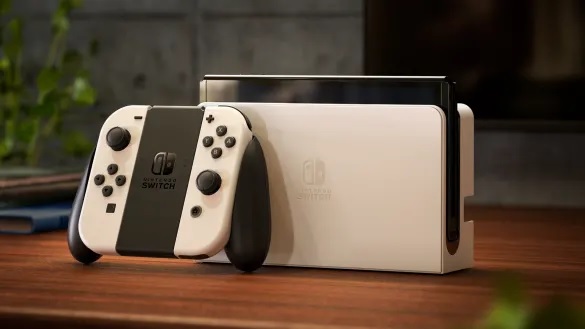Nintendo Switch OLED — here’s why I’m not upgrading
A new display and kickstand are not enough

After many months of dodging the topic, Nintendo has just announced a brand new Switch console: the Nintendo Switch OLED. No, it’s not the Nintendo Switch 2, or even the fabled Nintendo Switch Pro, but it is an upgrade over the current model.
But it’s not that much of an upgrade, and for that reason I have absolutely no desire to buy one for myself. Especially since I already have a Nintendo Switch that I’m quite fond of.
- Nintendo Switch OLED: release date, price, specs and new features
- Where to buy Nintendo Switch OLED: how to pre-order and buy
- Plus: RIP iPhone 12s: Apple will reportedly use iPhone 13 name for new iPhones
The Nintendo Switch OLED doesn’t offer much in the way of upgrades
As the name suggests, the main selling point of the OLED Switch is the new 7-inch OLED screen. Previous Switch models had a 6.2-inch LCD display, or 5.5 inches if you own a Nintendo Switch Lite.
On top of that, the new console also comes with 64GB storage, double the previous amount, an improved speaker system, and a more refined stand that looks significantly more impressive than the feeble one from the launch model Switch. An improved dock also comes with an Ethernet port, meaning you wouldn’t need to spend $29 on an adapter.
But as upgrades go, it’s all very underwhelming. Rumors had already suggested the new Switch would include a slightly larger OLED display, so that much is completely unsurprising. However, it was also rumored that the upgraded console would be able to output content in 4K when docked, which would be a first for Nintendo.
Sadly, that’s not the case, and Nintendo has confirmed that the Nintendo Switch OLED only outputs in 1080p in TV mode and 720p in handheld mode. Both of which are the same as the original Switch. While that’s good in terms of compatibility with existing Switch games, it’s still pretty disappointing.
Even as a handheld player, the Switch OLED has nothing to offer me
I almost exclusively play my Switch in handheld mode, but I'm not too excited about the OLED display.
Sign up to get the BEST of Tom's Guide direct to your inbox.
Get instant access to breaking news, the hottest reviews, great deals and helpful tips.
Sure, there's an appeal to having darker ‘true’ blacks, better image quality and better viewing angles. Then again, there’s always the risk of the dreaded OLED burn in, even if it takes a couple of years to kick in like it has on my phone.
Really, though, without any boost in resolution there’s nothing about the Switch’s display that would make me want to upgrade. Had it had a 1080p panel, maybe I could have been convinced to drop an extra $350 on a new handheld. But right now, OLED on its own isn’t enough to entice me.
Even the brand new, redesigned stand isn’t that impressive. Sure, the stand on the original Switch is absolute garbage, and feels unbalanced and ready to break at the slightest gust of wind.
Then again, the Switch’s tabletop mode has always been kind of a pain, especially considering the original console had such terrible battery life. It was pretty much impossible to play in tabletop mode while the system was plugged in, because the charging port is on the bottom of the system. Which is something the OLED Switch doesn’t do anything about.
For me that was as simple as buying a special battery case that added more power to my Switch, while also offering an adjustable stand. More to the point, the case’s battery port was on the side, which meant it could be plugged into an external power source during play.
While it’s important that Nintendo recognized the faults in the original Switch’s design, it’s one of the things that may not make a huge amount of difference to existing players. At the very least it can be classified as a bonus, rather than a definitive reason for upgrading.
Bottom line
The most important thing to mention here is that the Nintendo Switch OLED’s upgrades are not worthless. In fact, Nintendo has deliberately gone to the trouble of fixing some of the original Switch’s most problematic flaws. But for me those upgrades just aren’t enough, and are not worth me dropping $350 on a brand new console.
If my Switch were to mysteriously break down between now and October 8, it would be a totally different story. In fact, I’d be foolish to not consider the Switch OLED as a replacement for my hypothetical broken console. But, barring that specific scenario, this new upgrade doesn’t really have much to offer me.
If you don’t have a Switch, or want to upgrade from the Switch Lite, the OLED model is worth considering. But for those of you rocking the standard Switch, like I am, you may want to think twice before you rush off to secure your pre-order.
- More: Nintendo Switch OLED vs. Nintendo Switch — what's different?

Tom is the Tom's Guide's UK Phones Editor, tackling the latest smartphone news and vocally expressing his opinions about upcoming features or changes. It's long way from his days as editor of Gizmodo UK, when pretty much everything was on the table. He’s usually found trying to squeeze another giant Lego set onto the shelf, draining very large cups of coffee, or complaining about how terrible his Smart TV is.
